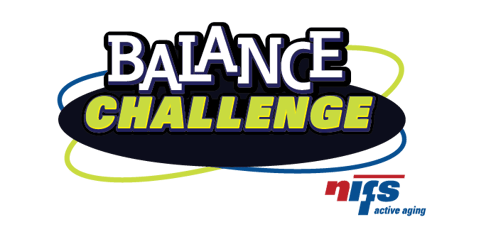 As you might know, just the fear of falling can have significant and lasting impact on older adults or family members’ quality of life. In fact, the fear itself is a risk factor for falls. The good news is that falls can be prevented through balance-specific training and education, which is why NIFS has adopted a comprehensive balance-training method that goes far beyond simply offering balance-training group fitness classes.
As you might know, just the fear of falling can have significant and lasting impact on older adults or family members’ quality of life. In fact, the fear itself is a risk factor for falls. The good news is that falls can be prevented through balance-specific training and education, which is why NIFS has adopted a comprehensive balance-training method that goes far beyond simply offering balance-training group fitness classes.
It's Time for the Annual Balance Challenge
As part of our commitment to improving balance and reducing the risk of falls, we launched the annual Balance Challenge in 2013 and have been expanding on it ever since. Residents across the country will join us this month as we March into Better Balance with the 8th Annual Balance Challenge. This hallmark program has truly become a fan favorite, and NIFS staff at senior living communities across the country will be focusing on educating their members on fall prevention while providing special balance-training classes, programs, and events.
Participants will be encouraged to complete a Fullerton Advanced Balance Assessment as well as a pre and post self-evaluation survey relating to their perceived levels of balance and confidence. During the month of March, participants will have the opportunity to choose from a menu of programming that includes a balance fair, a fall-prevention presentation, a workshop on how to get up from a fall if one were to occur, small group discussions addressing the fears surrounding falls, a home safety check, and multiple modalities of balance training through group fitness classes, circuit courses, balance games, and more.
One strong advantage of hosting the Balance Challenge is that it shines a spotlight on the fall-prevention program offerings readily available all year long in the fitness center. NIFS staff members regularly collaborate with rehab and the healthcare team at the communities we serve to support resident transitions into and out of therapy. Residents appreciate the opportunity to continue building on the gains they made in rehab with the help of NIFS degreed and certified staff in the fitness center. This strong collaboration with rehab and robust service menu of programs is a great service model for supporting resident well-being year round, and the Balance Challenge serves as a reminder of everything that is available.
Results of Last Year’s Balance Challenge
Last year’s Balance Challenge resulted in many valuable accomplishments:
- Perceived balance: Across the communities, participants’ perception of their balance taken from their pre and post self-evaluations demonstrated a 12% increase in confidence.
- Fear of falls: Across the communities, participants’ fear of falling decreased by 18% as reported from their pre and post self-evaluations following the Balance Challenge.
- Total visits: There was an average increase of 11% in total resident participation to the fitness centers in March 2019 compared to March 2018.
- Group fitness visits: Group fitness classes saw an average increase of 17% participation in March 2019 compared to March 2018.
- Appointment volume: Resident engagement increased by 32% in the number of appointments conducted in March 2019 compared to March 2018.
The data tells a story, and clearly the residents increase their participation in fitness program offerings when there is an emphasis on comprehensive fall-prevention programming. They truly turn out to learn, train, and experience these offerings.
NIFS partners with premier senior living providers across the US to bring their residents best-in-class fitness and wellness programming. The NIFS Balance Challenge is a great example of how our qualified fitness professionals have the skills and resources to support resident well-being while increasing education about fall prevention and increasing overall participation in the fitness program. Click here to learn more about resident successes from participating in NIFS fall-prevention programming. Looking to get started with some balance training exercises? Click here for inspiration!


.jpg?width=300&name=GettyImages-1157822544%20(1).jpg) We hear a lot about stability, but how do you accurately incorporate it into a client’s program? Understanding how to incorporate stability training will help keep your clients functional, independent, and healthy regardless of age.
We hear a lot about stability, but how do you accurately incorporate it into a client’s program? Understanding how to incorporate stability training will help keep your clients functional, independent, and healthy regardless of age.